Laptop Mag Verdict
The Overpowered Gaming Laptop 17+ offers solid specs for an affordable price but doesn't hold up very well in real-world use.
Pros
- +
Inexpensive
- +
Can run demanding games at high settings
- +
Lots of ports
Cons
- -
Poorly designed power cord
- -
Performance staggers
- -
Dodgy warranty
Why you can trust Laptop Mag
It's a cliche to make fun of Walmart, but there's a grain of truth at the center of the jokes. The retail giant's reputation for low prices over high quality appears to be well-earned. Take, for example, the Overpowered Gaming Laptop 17+ ($1,699; currently marked down to $999): Walmart's first attempt at a house-brand gaming laptop. The system is inexpensive and all of its specs look good on paper. However, its dim display, shaky real-world gaming performance and poorly designed power cord make it a tough recommendation at its full price.
Pricing and Configurations
The Overpowered 17+ comes in just one configuration ($1,699, but frequently marked down), which at least makes it easy to know what you're getting. You'll get a 256GB SSD, a 2TB hard drive and 32GB of RAM, in addition to an Intel i7-8750H processor and an Nvidia GTX 1060 GPU. This is more or less in line with what the machine's competitors offer, although exact hard-drive and RAM specifications vary by model.
Design
To give credit where it's due, the Overpowered 17+ gets points right off the bat for looking good without being overdesigned. The machine's black plastic chassis is unassuming, and the silver "Overpowered" logo on the lid is not nearly as aggressive as some of its competitors' designs.
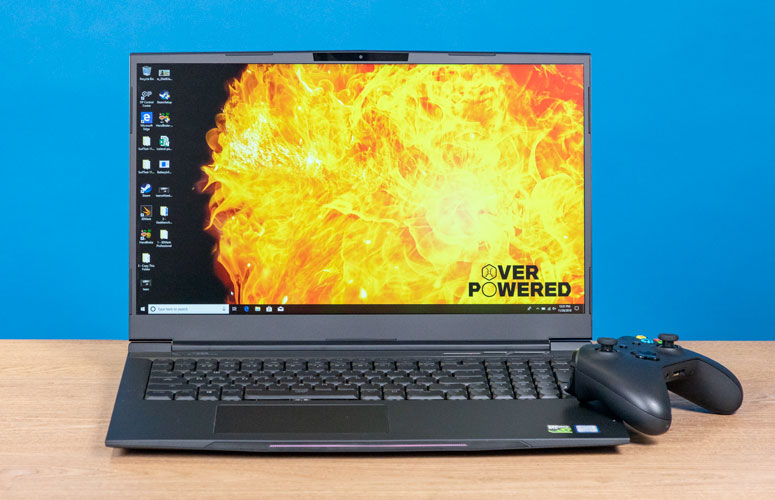
The machine is not obnoxiously large or heavy, measuring 15.6 x 10.3 x 1 inches and weighing 5.7 pounds.
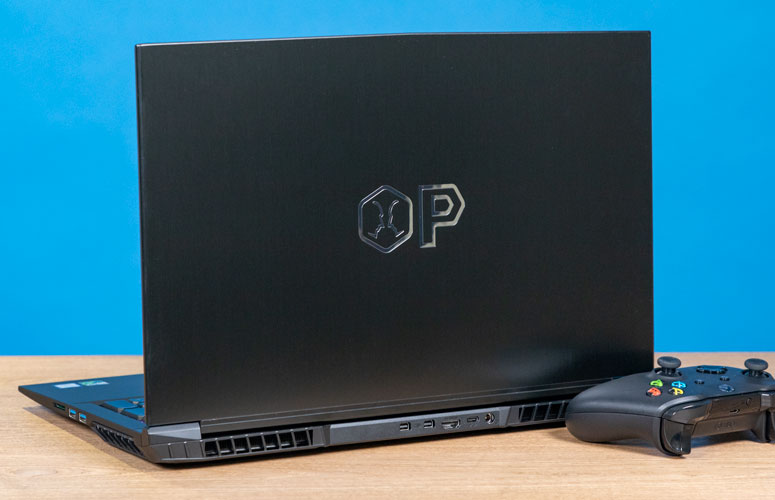
Compared to the Acer Predator Helios 500 (16.9 x 11.7 x 1.5 inches; 8.3 pounds), the Alienware 17 R5 (16.7 x 13.1 x 1.2 inches; 9.8 pounds) and the Asus ROG Strix Scar II (GL704GM) ($15.7 x 10.7 x 1.0 inches; 6.28 pounds), the Overpowered is easily one of the lightest and slimmest gaming laptops in its size class. This is at least partially due to the screen's nearly bezelless design, which gives you a lot more real estate than you might expect.
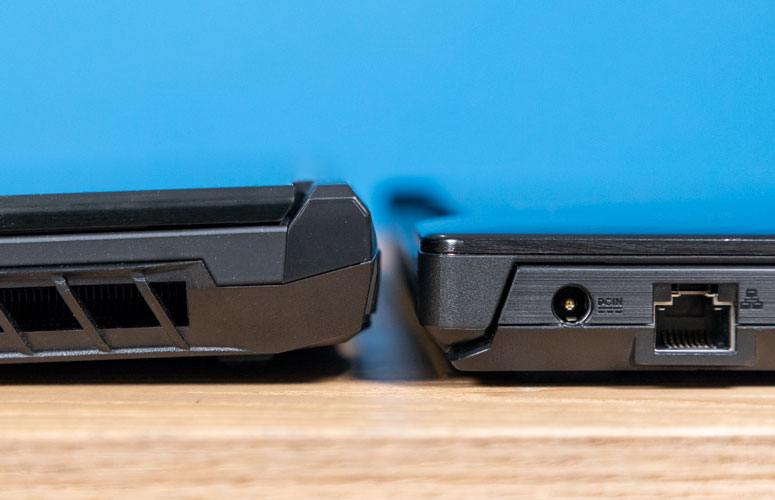
The one thing I didn't really understand was the LED light bar on the bottom half of the laptop. There's a thin strip of lighting on the front of the chassis, just below the touch bar. But this aesthetic touch doesn't really serve any purpose, since you're the only person who will ever see it, and it doesn't serve to illuminate anything. I'm not above a purely ornamental light now and then, but this is an odd place for one, considering you'll almost never actually look at it.
Ports
The Overpowered 17+ offers a generous assortment of ports. On the left, you'll find a Kensington lock, an Ethernet port, a USB 2.0 port and two 3.5-millimeter audio jacks: one for mics and one for headphones. On the right, there's an SD card reader and two USB 3.0 ports.
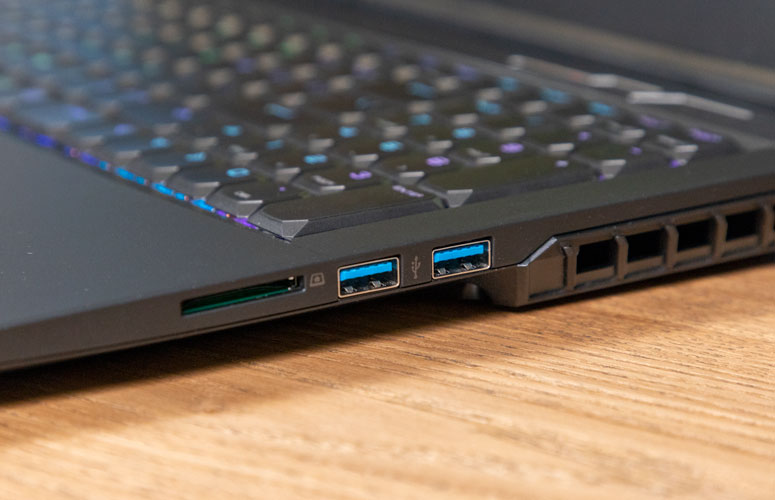
It's not until you get to the back that design issues start to rear their ugly heads. For some reason, Walmart squirreled the USB Type-C port all the way in the back, along with two Mini DisplayPorts and an HDMI port. I understand why the visual ports should go in the back of the device, but USB Type-C is the fastest way to charge most new gadgets, and it's not going anywhere anytime soon.
The Overpowered 17+ has one of the worst power ports of any laptop we've ever reviewed.
Having it at the back of the device is an incredible inconvenience, particularly if you're going to use the laptop as your always-connected home machine -- which, given its price, is very feasible.
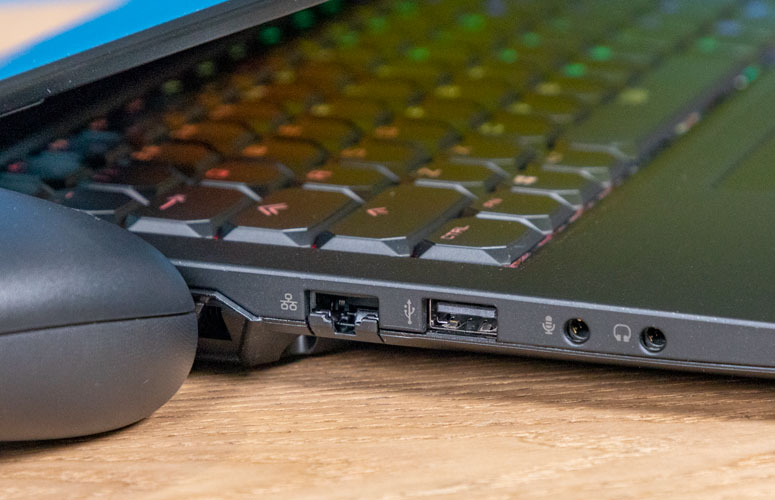
Or, rather, it would be feasible, if not for the power port. Our colleagues at Tom's Hardware were quick to point out that the Overpowered 17+ has one of the worst power ports of any laptop we've ever reviewed, and judging by reviews from other outlets and Walmart customers, we were not alone.
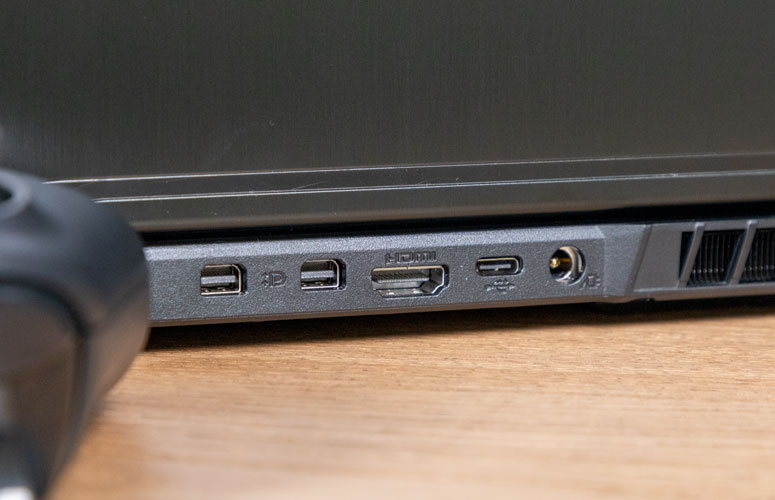
Everything about the power cord is loose. When I first picked up the brick, the adapter cord immediately fell out, even though I hadn't applied any pressure to it. Worse still, the jack doesn't fit into the port properly, meaning that you have to finagle it into place each and every time you use it. If you nudge the system ever so slightly, the cord will fall out. Or worse still, the cord will stay in place, but stop charging the machine. There's no real way to know, except to keep a sharp eye on the battery indicator in Windows. It's fair to say that for a laptop, particularly one with a paltry battery life (more on that later), this is a fatal flaw.
Display
When I first opened up the Overpowered 17+'s lid and saw the colorful 17.3-inch, 1080p screen with barely any bezels to hold it back, I was optimistic. But the more I used it, the more I realized that it didn't live up to its design potential.
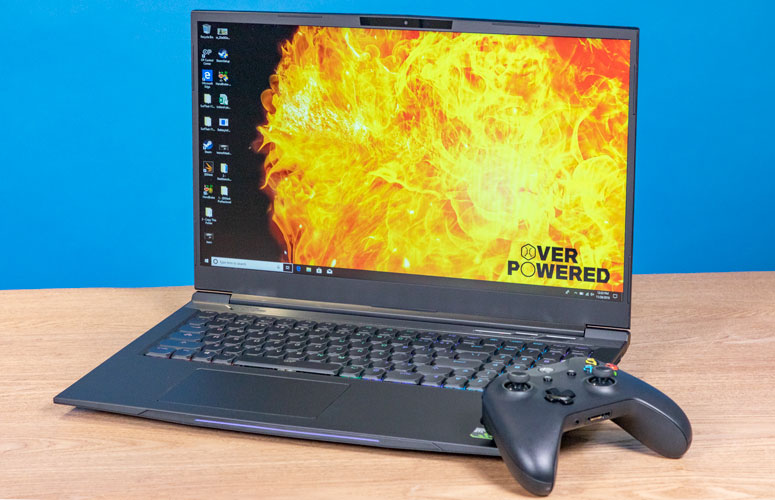
While I was playing Thronebreaker: The Witcher Tales, the game's vibrant countryside seemed a little dull, with muted green trees, golden armor and blue rivers. On its own, it wasn't so bad, but next to a dedicated gaming monitor, the Overpowered 17+ made a gorgeous game look just passable.
The biggest issue is that the screen just isn't that bright. It maxes out at 260 nits -- which, to be fair, is not that different from the Asus ROG Strix Scar II's 261 nits. But it's dimmer than the Acer Predator Helios 500 (276 nits) and a long way away from the Alienware 17 R5 (352 nits) or the category average for gaming laptops (290 nits).
MORE: Highest Resolution Screens
On the other hand, the Overpowered 17+'s color gamut of 120 percent exceeds the category average (115 percent) as well as three of its closest competitors (108 percent for the Acer; 110 percent for the Alienware; 114 percent for the Asus).
Keyboard and Touchpad
When Walmart first announced the Overpowered line, the retailer claimed that each laptop would come with authentic Cherry MX Brown switches. Many reviewers (myself included) were immediately skeptical of this claim; after all, Cherry MX Browns are not only expensive, top-of-the-line products, but they also don't generally fit into slimline laptops.
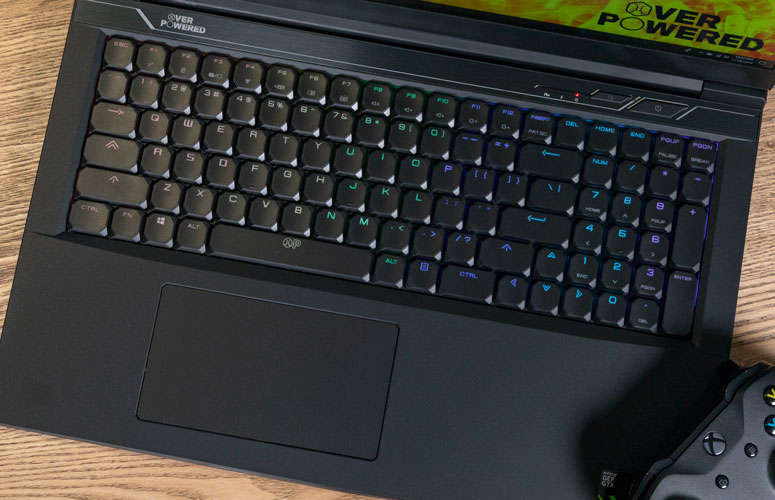
Well, there must have been a miscommunication somewhere, since the keys are mechanical, but definitely not Cherries. (The Walmart website now simply lists them as "mechanical RGB LED keys." I couldn't find a brand, even after prying off the keycaps.) I'm of two minds about this. On the one hand, it's almost always better to have mechanical keys than membranes, for both comfort and durability purposes.
Even with mechanical switches, the Overpowered's key travel feels shallow.
On the other hand, the Overpowered 17+'s mechanical keys don't feel all that much better than a decent membrane model. The 1.8-mm key travel is not so different from the 1.6 mm on the Acer, and the Alienware actually offers a much more comfortable 2.1 mm. (The Asus has only 1.4 mm, so the Overpowered 17+ is better in that regard, at least.)
Even with mechanical switches, the Overpowered's key travel feels shallow and bottoms out easily. They're also not the most reliable keys. While typing, I would frequently miss letters or press two keys together -- which is not hard to do, since they're crammed together so closely. You do get a full number pad, though, which is helpful.
You also get full RGB lighting for the keyboard, which is something of a rarity, even among dedicated gaming models. While you can't reprogram each individual key, there are a variety of patterns, including a rather attractive rainbow design. You can also make the whole keyboard a single color, if you prefer some unity in your life. The lighting isn't all that bright, however, even with the brightness turned up all the way, but it's nice to have and easy to control with the OP Control Center software.
MORE: Our Favorite Gaming Keyboards
The 5.2 x 2.8-inch touchpad positively dwarfs most other gaming laptop touchpads, which might be nice if it actually worked well, but that's not the case: The touchpad has a resistant, plasticine feel, which makes it difficult for you to drag your fingers across it.
Even then, it's often unresponsive, and its right- and left-click buttons have no clear delineations from the rest of the pad. Since it's a gaming laptop, you'll most likely be using a mouse most of the time, but I can't imagine trying to get serious work done with the Overpowered 17+ on a bus or a plane, particularly if it required any kind of precision.
Audio
It's a good thing that the Overpowered 17+ has a headphone jack and a lot of USB ports, because you're probably going to want some gaming headphones. The built-in speakers are not only quiet but also produce extremely flat and thin sound. Even with the volume turned up all the way, my Flogging Molly tracks reached only a mildly annoying volume, while at lower levels, they weren't audible at all.
Needless to say, the speakers aren't really up to the challenge of providing good game audio, either. Music, dialogue and sound effects all sounded pretty muddled in Thronebreaker. In multiplayer games like StarCraft: Remastered and Destiny 2, this shortcoming was even more noticeable. Directional sound barely comes through, and it can be hard to tell whether you're being shot at or if some part of your base is under attack.
Luckily, this seems to be an issue with the speakers rather than the sound card, because everything sounds fine with a headset plugged in. Just be sure to have one handy before you pick up the Overpowered 17+.
Gaming, Graphics and VR
Powered by an Nvidia GeForce GTX 1060 with 6GB VRAM, the Overpowered 17+ beats the category averages for gaming in many respects, but still falls short of its closest competitors. The system pulled 37 frames per second with Rise of the Tomb Raider set to 1080p on Very High graphics settings. That's better than the 34-fps average, but not quite as good as the Asus (37 fps; GTX 1060) and much weaker than the Acer (55 fps; GTX 1070) and the Alienware (68 fps; GTX 1080).
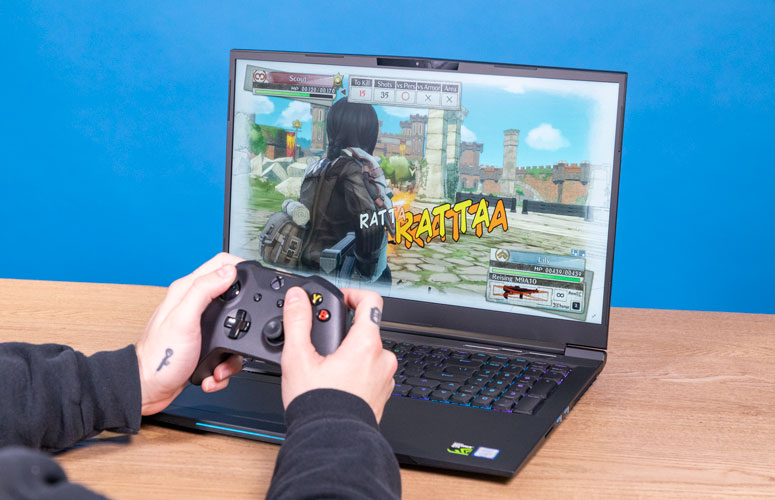
The Overpowered 17+ pulled off 71 fps against a category average of 66 fps for Hitman. But the Asus pulled 73 fps, the Alienware pulled 99 fps and the Acer pulled 103 fps. Consider also Middle-earth: Shadow of War, where the Overpowered 17+ fell short of the 62-fps category average, scoring 53 fps. That's also below the Asus' 73 fps, the Alienware's 95 fps and the Acer's 82 fps.
In real-world testing, the machine could indeed handle demanding games at high settings. But the experience was never as consistent as I would have liked. From Destiny 2 to Thronebreaker, the games would occasionally stagger and lag before returning to a consistent frame rate. It never happened more than once every 15 minutes or so -- but it also happened during every game session, sooner or later. During a single-player game, this is an annoyance; during multiplayer games, it's a death sentence.
MORE: The Best PC Games to Play Right Now
For VR aficionados, the system can handle the technology acceptably well, earning a 7 out of 11 on SteamVR's performance test. Granted, the Asus earned 7.4, the Alienware earned 11 and the Acer earned 10.4, but the Overpowered 17+ did exceed the 6.2 category average.
Performance
Apart from gaming, the Overpowered 17+ handled day-to-day tasks very well. I browsed Facebook and Twitter, checked my email, watched a Netflix video, streamed music in Spotify and worked on two different Microsoft Office programs -- all without any slowdown, thanks to the system's Intel i7-8750H processor and 32GB of RAM.
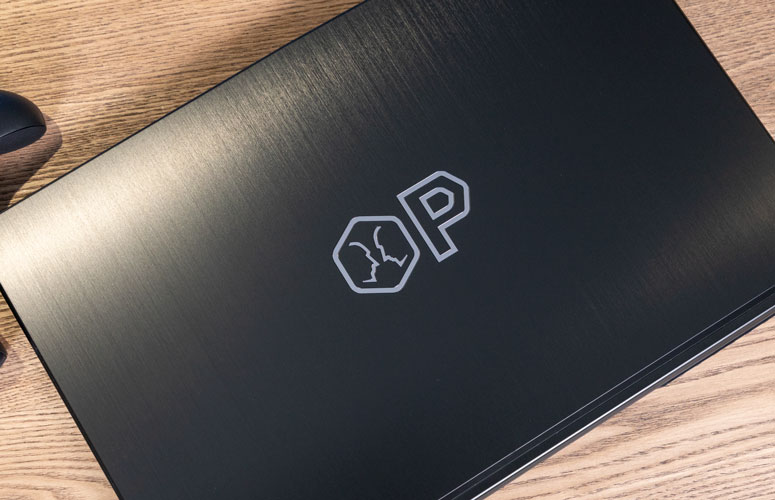
The Overpowered 17+ did better on general benchmarks than it did on gaming benchmarks, interestingly enough. On the Geekbench 4.1 performance test, the system earned a score of 22,633, comfortably beating the category average (20,220) as well as the Acer (211,94; Intel Core i9-8950HK), the Alienware (21,333; Intel Core i9-8950HK) and Asus (19,572; Intel Core i7-8750H).
Likewise, transcoding a 4K video into 1080p took 8 minutes and 59 seconds on the Overpowered 17+, compared to 11:27 for the category average, 9:33 on the Acer, 9:10 on the Alienware and 11:37 on the Asus.
Matching names and addresses on a huge Excel spreadsheet took the Walmart laptop 35 seconds, while the Acer took 40, the Alienware took 42 and the Asus took 46. (The category average was 49.) Granted, it's not a night-and-day difference, but the Overpowered 17+ offers plenty of power for everyday office work.
The only place where the laptop really fell down was in taking 25 seconds to transfer 5GB worth of data from a USB drive to its 2TB SATA hard drive, for a transfer rate of 200MB/second. Its three closest competitors took half that time, or less.
Battery Life
The Overpowered 17+ simply does not have very good battery life, which is especially problematic, given how difficult it is to charge the darned thing. The Laptop Mag Battery test (which consists of continuous web surfing over Wi-Fi) rated it for 2 hours and 36 minutes, which fell far short of the 4:15 average. The Acer also managed only 2:36, but the Alienware and Asus did much better, at 3:47 and 3:37, respectively. No one expects a gaming laptop to last especially long, given how much juice its hardware drains, but 2.5 hours won't even last for half of a cross-country flight.
Webcam
The webcam on the Overpowered 17+ is nothing special, but it gets the job done. When I video chatted into the Tom's Guide morning meeting, my image looked washed out and a little grainy, even though the camera did a fairly good job capturing details like the design on my shirt.
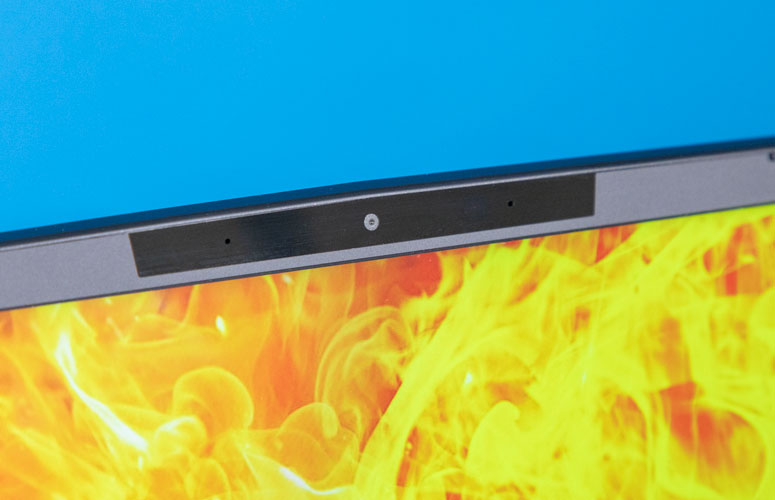
Likewise, my co-workers described the microphone as "tinny" and "muffled," so a gaming headset is probably your best bet if you intend to do a lot of multiplayer.
Heat
The Overpowered 17+ got much hotter than we'd hoped, particularly on its touchpad and keyboard (101 degrees and 102 degrees Fahrenheit, respectively). Laptop Mag deems anything over 95 degrees too hot to handle for an extended period of time -- which is why it's particularly problematic that the underside of the Overpowered 17+ reached 99 degrees. It's not going to burn your pants off, but if you don't have a table handy, don't expect to use the laptop for all that long.
Software and Warranty
Thankfully, the Overpowered 17+ is mercifully free of bloatware, coming with just the standard array of Windows 10 programs and an Overpowered Control Center app for the keyboard.
Warranty information is a little harder to parse. On its website, Walmart promises a "2-year warranty" on the device, but never clarifies exactly what that covers. This is confusing, since the user manual explicitly specifies a one-year warranty, with labor costs covered for only the first 90 days. (No matter what, the end user is responsible for shipping costs.)
The company doesn't offer any clues as to what labor might cost past the first 90 days, so you'd better hope that nothing goes wrong -- and take a screenshot of the "2-year warranty" promise on the website, just in case.
Bottom Line
Even though the Overpowered 17+ looks great on paper, its real-life performance leaves something to be desired. It doesn't live up to more experienced gaming brands on benchmarks, and a whole host of minor flaws impede everyday gaming in noticeable ways.
That's not to say the product is irredeemable, though -- especially if you can get it on sale (the $1,000 price is very tempting). And, the system has good specs, and it can indeed run some demanding games at high settings. It's good for productivity, too -- if you can wrangle the junky power cord.
Still, like a lot of Walmart products, it's hard to shake the feeling that the laptop was cobbled together out of the cheapest possible parts, and there's an old saying that it's expensive to be cheap. I wonder how long the system will last, and how easy it will be to repair once the questionable warranty period expires.
I won't say that you should completely avoid the Overpowered 17+. It's inexpensive and offers decent specs for the price. But if you can spring for a more premium laptop such as the Predator Helios 500 ($1,999 starting) or Alienware 17 R5 ($1,399 starting), you'll be better off in the long run.
Credit: Laptop Mag
Overpowered Gaming Laptop 17+ Specs
| Brand | Walmart |
| CPU | Intel Core i7-8750H |
| Card Slots | SD memory reader |
| Company Website | https://www.walmart.com/ip/OVERPOWERED-Gaming-Laptop-17-144Hz-Intel-i7-8750H-NVIDIA-GeForce-GTX-1060-Mechanical-LED-Keyboard-256-SSD-2TB-HDD-32GB-RAM-Windows-10/887474519 |
| Display Size | 17.3 |
| Graphics Card | Nvidia Geforce GTX 1060 (6GB)and Intel UHD Graphics 630 (integrated) |
| Hard Drive Size | 1 TB |
| Hard Drive Type | SATA Hard Drive |
| Native Resolution | 1920x1080 |
| Operating System | Windows 10 |
| Optical Drive | None |
| Ports (excluding USB) | Kensington Lock, Mini DisplayPort, USB 3.1 with Type-C, USB 2.0, Audio-in, USB 3.0, Ethernet, HDMI, Headphone |
| RAM | 32GB |
| Secondary Hard Drive Size | 256GB |
| Secondary Hard Drive Type | SSD |
| Size | 15.6 x 10.3 x 1 inches |
| Touchpad Size | 5.2 x 2.8 inches |
| USB Ports | 4 |
| Video Memory | 6 GB |
| Warranty/Support | 1 year limited |
| Weight | 5.68 pounds |
